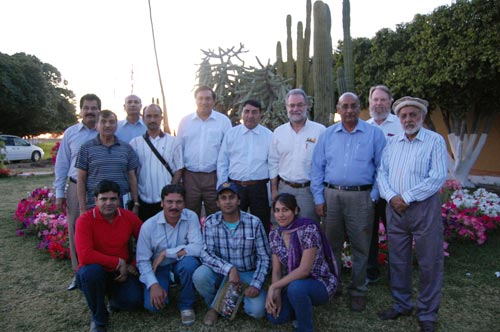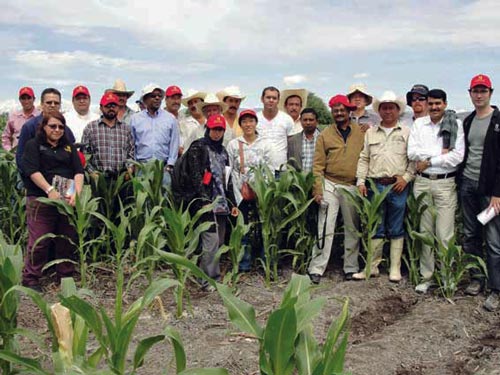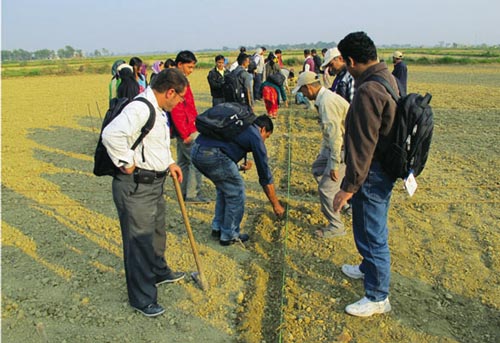Pakistani representatives make a welcome return to CIMMYT Mexico
 For some attendees, the unveiling of the new Norman E. Borlaug statue at CENEB was particularly poignant. It was a young Pakistani researcher who, in 1961, selected the variety that later became known asMexipak; a high-yielding, white grain wheat that became one of the mega-varieties that launched the Green Revolution. In 1966, Pakistan imported 41,000tons of Mexipak seed from Mexico – one of the biggest seed imports in history. Quarantine restrictions would make this a difficult task today, but it is estimated thatthis large-scale mission saved one million people from starvation and famine during the Green Revolution.
For some attendees, the unveiling of the new Norman E. Borlaug statue at CENEB was particularly poignant. It was a young Pakistani researcher who, in 1961, selected the variety that later became known asMexipak; a high-yielding, white grain wheat that became one of the mega-varieties that launched the Green Revolution. In 1966, Pakistan imported 41,000tons of Mexipak seed from Mexico – one of the biggest seed imports in history. Quarantine restrictions would make this a difficult task today, but it is estimated thatthis large-scale mission saved one million people from starvation and famine during the Green Revolution.
Norman Borlaug continued his relationship with Pakistan, though CIMMYT had to close it’s office there in the 1980s. This office was reopened in 2010,and during this year’s Visitors Week at CENEB, Ciudad Obregon, CIMMYT was delighted to welcome a delegation of eight Pakistanis, representing thePakistani Agricultural Research Council (PARC), the Ministry of Food Security and Research, the Nuclear Institute for Food and Agriculture, and the Directors General of Agriculture Research from Khyber Pakhtunkhwa (KPK) and Sindh, two of Pakistan’s fourprovinces. Rick Ward, Head of CIMMYT’s office in Pakistan, accompanied the delegates, who joined four Pakistani Borlaug Fellows currently conducting research at CENEB.
Syed Ghanzanfar Abbas, Director of Mechanization, PARC, said that visiting CIMMYT-Mexico was “a dream come true”. The delegates were delighted to see the research that CIMMYT is conducting at CENEB, and enjoyed hearing the presentations and meeting CIMMYT staff.
 “It is very difficult to find conservation agriculture machinery. You have to go to China or India to get it,” said Mahesh Kumar Gathala, new CIMMYTBangladesh-based cropping systems agronomist for South Asia. Gathala, a native of India, was just one of the 15 participants invited to attend a five-week conservation agriculture course at CIMMYT-El Batán, Mexico, where improving machinery and professional capacity were hot topics.
“It is very difficult to find conservation agriculture machinery. You have to go to China or India to get it,” said Mahesh Kumar Gathala, new CIMMYTBangladesh-based cropping systems agronomist for South Asia. Gathala, a native of India, was just one of the 15 participants invited to attend a five-week conservation agriculture course at CIMMYT-El Batán, Mexico, where improving machinery and professional capacity were hot topics. The Wheat Research Center (WRC) in Bhairahawa welcomed 20 early and mid-career wheat breeders from four CSISA countries (Bangladesh, India, Nepal, and Pakistan) to its scenic campus in Nepal’s Terai region to participate in a two-week regional Wheat Improvement and Pathology course which was organized in collaboration with Nepal Agricultural Research Council (NARC) from 29 November- 12 December 2010.
The Wheat Research Center (WRC) in Bhairahawa welcomed 20 early and mid-career wheat breeders from four CSISA countries (Bangladesh, India, Nepal, and Pakistan) to its scenic campus in Nepal’s Terai region to participate in a two-week regional Wheat Improvement and Pathology course which was organized in collaboration with Nepal Agricultural Research Council (NARC) from 29 November- 12 December 2010.